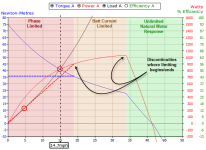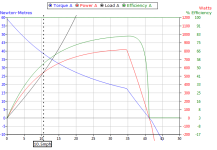Make More Pi
10 mW
This started as an email to ebikes.ca, who from here on I will refer to as GT, short for Grin Tech. GT graciously turned around a response in just a few hours.  The answer is satisfactory but I would like to go into a few details on this subject and thought it would be beneficial to make this into a thread, so here we are.
The answer is satisfactory but I would like to go into a few details on this subject and thought it would be beneficial to make this into a thread, so here we are.
I will be referring to the simulator at http://www.ebikes.ca/tools/simulator.html.
-- my message to GT --
I usually use peddle assist but I get a lot of questions about performance so I decided to do some hill climbing without peddling. I found that my performance did not reach simulation expectations by far.
I will focus on the steepest hill that I ran my tests on. It is 1.3 miles of 7.5% to 9%, mostly 8%. I started with a battery voltage of 54.6V standing still and ended with 51.8 V. I began at the bottom of this hill with a motor temp of 38.7C, ambient temp about 18.3C, and went full throttle. My total weight is 250lbs with 1.95”x26” wheels on a mountain bike frame. My current limit is 25A. The CA says my bat resistance is 0.06~0.08ohm. I've set no power limit.
As I climbed this hill I believe my top speed on the bottom half was maybe 12 mph but was mostly around 9 mph. The slope, quite constant, 8%.
Almost 1 mile up I reached a slightly steeper portion, 9%, where my speed crept slower and got down to 3mph.
I watched my motor temp. At this steepest portion it was 85C. As the slope leveled out some, 8%, my speed increased, temp still climbing and it got to 90C where I saw the over temp flag go up and I could see the CA cut the current back, 21A. (That came after the 3mph portion) The peek temp was 95C.
Now lets run a sim. Clyte H3540, Battery 51.8V 0.08ohm 12.3Ah, 25A IRFB4110 Controller, full throttle, 26” wheel, mountain bike, 250lbs, 9% grade. Sim says 14.3 mph, overheat in 16 minutes.
14.3mph is 4 times 3 mph. So what am I missing here? I tell my friends to use your sim when they are shopping for parts but how do I explain this difference? I believe you have done a lot of good work with the sim ; have I done something wrong?
; have I done something wrong?
-- response from GT --
-- end of response from GT --
Thank you, GT, for you response! If I understand this correctly, the short answer is that as the temperature increase my motor looses efficiency at low RPMs and temperature effects are not simulated at http://www.ebikes.ca/tools/simulator.html, correct?
If I understand this correctly, the short answer is that as the temperature increase my motor looses efficiency at low RPMs and temperature effects are not simulated at http://www.ebikes.ca/tools/simulator.html, correct?
Perhaps that should be enough but I'm seeking a deeper understanding. So I want to pick this apart. Hopefully this can benefit others with an opportunity to share knowledge or to learn.
I was really surprised at how poorly my bike performed on this hill. My guess is that if I were to wait for the motor to cool to around 23 C then I would see much better results. Nevertheless, this experiment has made these phenomenon stick out like a sore thumb. I want to understand the details. I'll appreciate the help.
I will be referring to the simulator at http://www.ebikes.ca/tools/simulator.html.
-- my message to GT --
I usually use peddle assist but I get a lot of questions about performance so I decided to do some hill climbing without peddling. I found that my performance did not reach simulation expectations by far.
I will focus on the steepest hill that I ran my tests on. It is 1.3 miles of 7.5% to 9%, mostly 8%. I started with a battery voltage of 54.6V standing still and ended with 51.8 V. I began at the bottom of this hill with a motor temp of 38.7C, ambient temp about 18.3C, and went full throttle. My total weight is 250lbs with 1.95”x26” wheels on a mountain bike frame. My current limit is 25A. The CA says my bat resistance is 0.06~0.08ohm. I've set no power limit.
As I climbed this hill I believe my top speed on the bottom half was maybe 12 mph but was mostly around 9 mph. The slope, quite constant, 8%.
Almost 1 mile up I reached a slightly steeper portion, 9%, where my speed crept slower and got down to 3mph.
I watched my motor temp. At this steepest portion it was 85C. As the slope leveled out some, 8%, my speed increased, temp still climbing and it got to 90C where I saw the over temp flag go up and I could see the CA cut the current back, 21A. (That came after the 3mph portion) The peek temp was 95C.
Now lets run a sim. Clyte H3540, Battery 51.8V 0.08ohm 12.3Ah, 25A IRFB4110 Controller, full throttle, 26” wheel, mountain bike, 250lbs, 9% grade. Sim says 14.3 mph, overheat in 16 minutes.
14.3mph is 4 times 3 mph. So what am I missing here? I tell my friends to use your sim when they are shopping for parts but how do I explain this difference? I believe you have done a lot of good work with the sim
-- response from GT --
The simulator is not modeling the phase current limit of the motor controller as well as the effects of higher temperature on the motor winding resistance, nor saturation effects either, and so you need to be mindful of this especially in the region where the motor is in the current limited region and especially at low speeds near a stall.
The significant difference between 14mph here and 3mph here is not a factor of 4 in speed, but just a factor of _maybe_ like 15% in the torque output. ie, to climb a very steep hill at 14mph only takes a very small amount more torque on the wheel than to climb it at 3-4 mph, since virtually all the torque is needed to overcome gravity which is independent of your velocity. Therefor any factors (like increasing motor winding resistance, or stator saturation) that decrease the torque output of the motor in this regime will have a very large effect on the computed speed. Change your weight from say 250lb to 275lb and you'll see what I mean. Or change your 9% grade to a 10% grade.
I tell my friends to use your sim when they are shopping for parts but how do I explain this difference? I believe you have done a lot of good work with the sim; have I done something wrong?
I should probably have a note to be cautious of any results when you are down at <30% or so of the unloaded motor speed, since then these secondary effects have enough of an impact to significantly affect the results, as you are often right on the edge of the motor having enough torque for the task at hand or not. When you are not in the current limited regime, then simulation results are almost perfectly consistent with what you'd see on the ground.
btw, we are working on a simulation program that does indeed have full thermal modeling of the motor over the course of a trip, you can see beta preview of that here:
http://www.ebikes.ca/tools/trip-simulator.html
right click points the top graph in order to manually generated your elevation profile map, and then left click to drag the nodes around. %grade between adjacent nodes is shown in real time as you drag them.
-- end of response from GT --
Thank you, GT, for you response!
Perhaps that should be enough but I'm seeking a deeper understanding. So I want to pick this apart. Hopefully this can benefit others with an opportunity to share knowledge or to learn.
As I understand this, the CA is commanding the controller through the throttle signal and will only drive the throttle signal to the point that the controller is taking 25A from the battery. So that's our input limit to our controller. The phase current is what the controller is sending to the motor. I looked around the web to find a full spec sheet that could tell me more about this but have not found it yet. Does anyone have a link to it?The simulator is not modeling the phase current limit of the motor controller...
I do know that as heat increases so does coil resistance. If you want to prove this to yourself, try this experimental. If you can, find an incandescent light bulb, say a 100 watt. Measure the resistance. You might be quite surprised how low it is, between 5 to 10 ohm. But, if you were connect that bulb to your bike battery (say 50V) through a current meter, you'll see a current perhaps in the range of 2 amps. Solving for R you get 25 Ohm. Yes, the bulb is vary hot and the resistance increased.... effects of higher temperature on the motor winding resistance ...
Does someone want to tackle explaining what that is? I imagine it has something to do with magnetic flux.... saturation effects ...
I was really surprised at how poorly my bike performed on this hill. My guess is that if I were to wait for the motor to cool to around 23 C then I would see much better results. Nevertheless, this experiment has made these phenomenon stick out like a sore thumb. I want to understand the details. I'll appreciate the help.



